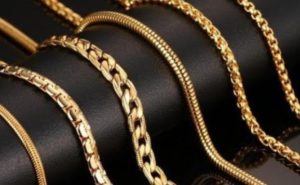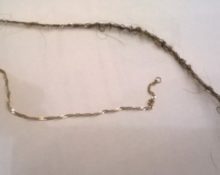They decorated themselves with a gold chain even before antiquity, in the cultures of Mesopotamia. It remains perhaps the most popular decoration today. Read on to learn how a small gold bar turns into jewelry.
How are gold chains made at a jewelry factory?
The process of creating this openwork beauty is labor-intensive and fascinating, although it is much easier for modern craftsmen than for jewelers of antiquity.
Historical reference! In the ancient world, only those of the royal family could wear gold faces - this was how divine origin was demonstrated. Later, the absence of such a pedigree was successfully replaced by wealth.
Step-by-step process for creating a chain
The path from a gold bar to jewelry looks like this:
 alloy preparation;
alloy preparation;- cooling the alloy in the casting machine;
- mold processing;
- rolling through a crimping machine;
- stan-tendem processing;
- heating in an oven;
- processing on a diamond mill.
At the end of all the manipulations, whole coils of gold wire are obtained, from which chains of different weaves are then made!
Interesting! Jewelry factory employees not only have to go through a metal detector at the end of their shift, but also refuse to wear jewelry! So that there is not only theft, but also the slightest suspicion of it.
The path of transforming metal into a chain is fascinating already at the stage of preparing the alloy: a product of the highest standard does not consist of pure gold! The excessive softness of pure gold requires impurities. The reddish tint is provided by the addition of copper, and brass allows you to speed up the process of creating the alloy obtained in crucibles. Melting point – 1010°C. Depending on the proportions of additives, an alloy of either 14 or 18 carats is obtained.
 The mixture must be hardened - this happens in the water of the casting machine, from where the workpiece enters the round mold. The gold that passes through it turns... into a two-meter pole! It is cut in half and squared in a rolling mill. After that, the rollers of the tandem mill pull the workpiece into the thickness of vermicelli, twisted into a spiral 24 m long.
The mixture must be hardened - this happens in the water of the casting machine, from where the workpiece enters the round mold. The gold that passes through it turns... into a two-meter pole! It is cut in half and squared in a rolling mill. After that, the rollers of the tandem mill pull the workpiece into the thickness of vermicelli, twisted into a spiral 24 m long.
Now you need to draw the gold into wire - the spiral is sent to the furnace, unrolled and passed through a mill with diamonds, poured with liquid lubricant. Bottom line - 3 km of gold wire wound into a spool.
Having finally warmed it up in the oven, they begin to weave chains on special machines. To prevent almost finished products from sticking together, they are sprinkled with a special powder and heated again to 815°C.
Having attached the fasteners, for which there is a special machine, and having marked the sample, the almost finished chains are sequentially immersed in four tanks with chemical solutions - this way all contaminants are washed away. Finally, gold items are coated with liquid gold for shine.
If the quality control specialist finds no errors, the jewelry goes on sale.
Methods of weaving gold chains
The design of the product depends on the weaving method. The most common:
 "rope";
"rope";- Venetian weaving;
- anchor weaving;
- "spider".
Rope weaving remains the simplest: by passing the wire through a couple of links, the machine closes them.
The anchor method requires a more complex machine that reproduces the technology for making an anchor chain, but in a miniature version. The wire passes through one link, the ends are closed and the next link is made. At a speed of 600 links per minute! The “Spider” is made in a similar way.
Venetian weaving requires a special machine - the wire in a special channel is twisted by mechanical clamps around the form, connecting to the previous link. The quality of links produced on any machine is monitored by a special specialist.
Interesting! Despite all the advances, there are types of weaving that are done exclusively by hand. Therefore, the profession of chain tying is rare, but still relevant. Only those with truly golden hands can master it!


 alloy preparation;
alloy preparation; "rope";
"rope"; 0
0





